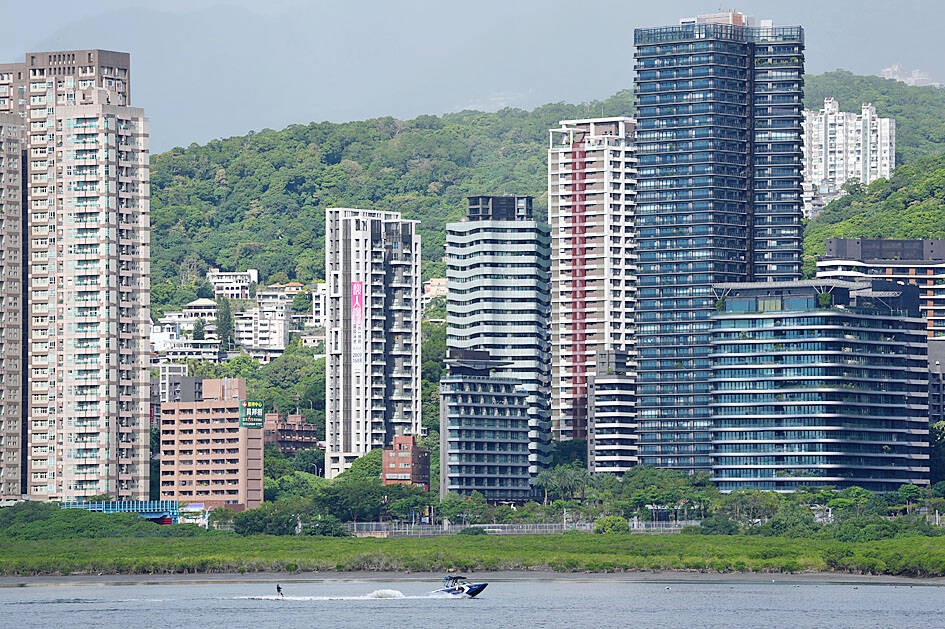Taiwan’s rapidly aging population is fueling a sharp increase in homes occupied solely by elderly people, a trend that is reshaping the nation’s housing market and social fabric, real-estate brokers said yesterday.
About 850,000 residences were occupied by elderly people in the first quarter, including 655,000 that housed only one resident, the Ministry of the Interior said.
The figures have nearly doubled from a decade earlier, Great Home Realty Co (大家房屋) said, as people aged 65 and older now make up 20.8 percent of the population.

Photo: CNA
“The so-called silver tsunami represents more than just a demographic shift — it could fundamentally redefine the balance of supply and demand in the housing market,” Great Home Realty research director Lai Chih-chang (賴志昶) said.
The phenomenon is evident across Taiwan’s six largest metropolitan areas.
Taipei had 116,000 elderly-occupied homes, up 71 percent from 2016, while the number in New Taipei City surged 108 percent to 165,000 — the highest nationwide, Lai said.
Taoyuan recorded the fastest expansion, rising 128 percent to 67,000 homes, followed by Taichung with 80,000 (up 111 percent). In southern Taiwan, Tainan’s elderly-only homes climbed 77 percent to 67,000, while Kaohsiung’s soared 91 percent to nearly 109,000.
A similar surge occurred in homes occupied by just one elderly person, government data showed.
Taipei recorded 89,000 such units, up 71 percent from 2016, while New Taipei City had 131,000, up 109 percent. Taoyuan again led with a 132 percent spike to 52,000 homes, followed by Taichung’s 60,000 (up 118 percent). The number of single-resident homes occupied by someone aged 65 or older also soared in Tainan and Kaohsiung, 84 percent and 95 percent respectively.
Lai attributed the acceleration to urban redevelopment, smaller household sizes and youth migration to new residential areas, leaving many elderly parents to live alone.
“In cities such as Taoyuan, Taichung and New Taipei City, new housing developments have coincided with a stronger trend of household separation, pushing up the number of elderly people living alone,” he said.
H&B Realty Co (住商不動產), Taiwan’s largest brokerage by franchise count, reported similar findings.
The rapid rise in single-resident households occupied by an elderly person underscores mounting pressure from an aging population and evolving family structures, H&B chief researcher Jessica Hsu (徐佳馨) said.
Growing demand for age-friendly housing — particularly units with elevators, barrier-free layouts and proximity to healthcare services — is set to reshape Taiwan’s property landscape, she said.
As younger people move out, elderly parents are increasingly left behind, fueling housing demand centered on elderly-friendly facilities and accessible living environments, she said.
With elderly people projected to account for more than one-quarter of the population within the next decade, developers and policymakers face growing pressure to adapt urban planning, housing design and community care systems for an increasingly gray society.

CHIP RACE: Three years of overbroad export controls drove foreign competitors to pursue their own AI chips, and ‘cost US taxpayers billions of dollars,’ Nvidia said China has figured out the US strategy for allowing it to buy Nvidia Corp’s H200s and is rejecting the artificial intelligence (AI) chip in favor of domestically developed semiconductors, White House AI adviser David Sacks said, citing news reports. US President Donald Trump on Monday said that he would allow shipments of Nvidia’s H200 chips to China, part of an administration effort backed by Sacks to challenge Chinese tech champions such as Huawei Technologies Co (華為) by bringing US competition to their home market. On Friday, Sacks signaled that he was uncertain about whether that approach would work. “They’re rejecting our chips,” Sacks

It is challenging to build infrastructure in much of Europe. Constrained budgets and polarized politics tend to undermine long-term projects, forcing officials to react to emergencies rather than plan for the future. Not in Austria. Today, the country is to officially open its Koralmbahn tunnel, the 5.9 billion euro (US$6.9 billion) centerpiece of a groundbreaking new railway that will eventually run from Poland’s Baltic coast to the Adriatic Sea, transforming travel within Austria and positioning the Alpine nation at the forefront of logistics in Europe. “It is Austria’s biggest socio-economic experiment in over a century,” said Eric Kirschner, an economist at Graz-based Joanneum

BUBBLE? Only a handful of companies are seeing rapid revenue growth and higher valuations, and it is not enough to call the AI trend a transformation, an analyst said Artificial intelligence (AI) is entering a more challenging phase next year as companies move beyond experimentation and begin demanding clear financial returns from a technology that has delivered big gains to only a small group of early adopters, PricewaterhouseCoopers (PwC) Taiwan said yesterday. Most organizations have been able to justify AI investments through cost recovery or modest efficiency gains, but few have achieved meaningful revenue growth or long-term competitive advantage, the consultancy said in its 2026 AI Business Predictions report. This growing performance gap is forcing executives to reconsider how AI is deployed across their organizations, it said. “Many companies

France is developing domestic production of electric vehicle (EV) batteries with an eye on industrial independence, but Asian experts are proving key in launching operations. In the Verkor factory outside the northern city of Dunkirk, which was inaugurated on Thursday, foreign specialists, notably from South Korea and Malaysia, are training the local staff. Verkor is the third battery gigafactory to open in northern France in a region that has become known as “Battery Valley.” At the Automotive Energy Supply Corp (AESC) factory near the city of Douai, where production has been under way for several months, Chinese engineers and technicians supervise French recruits. “They